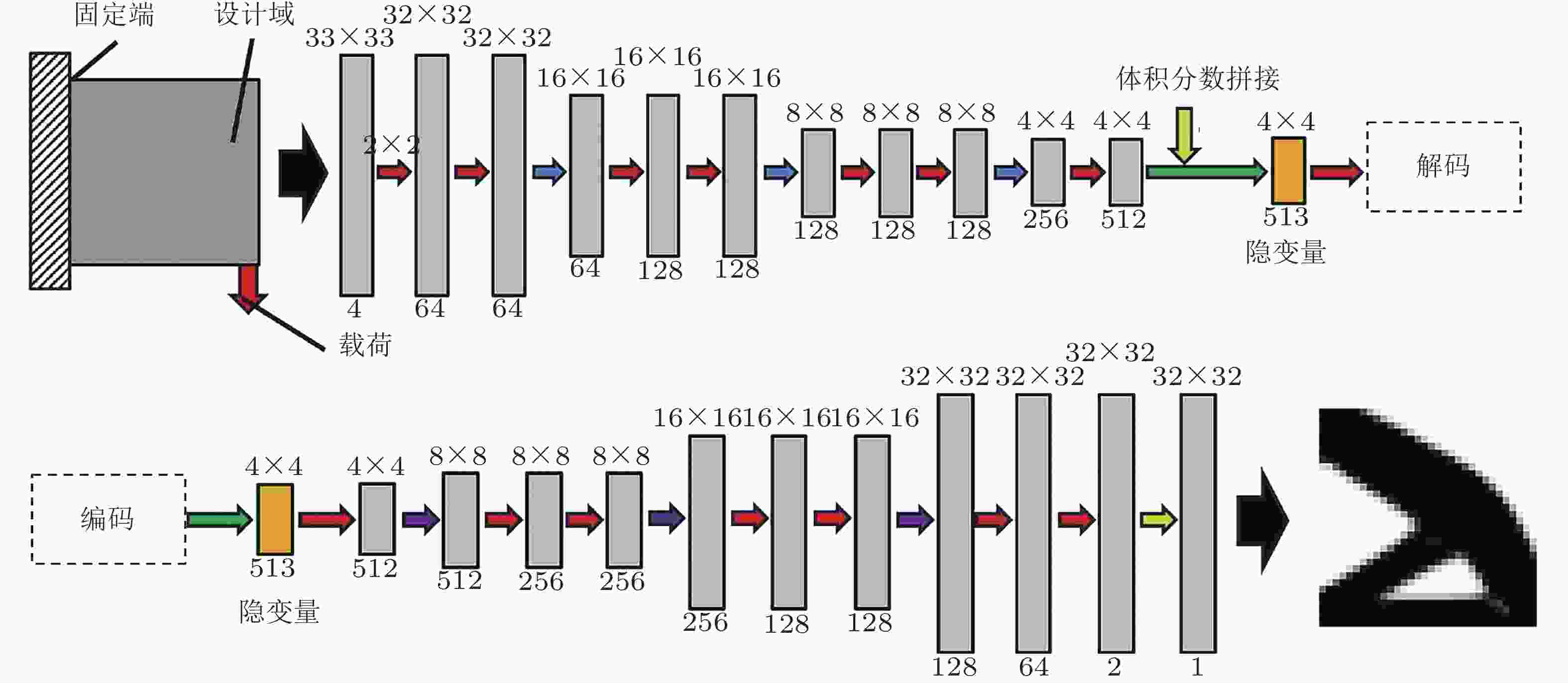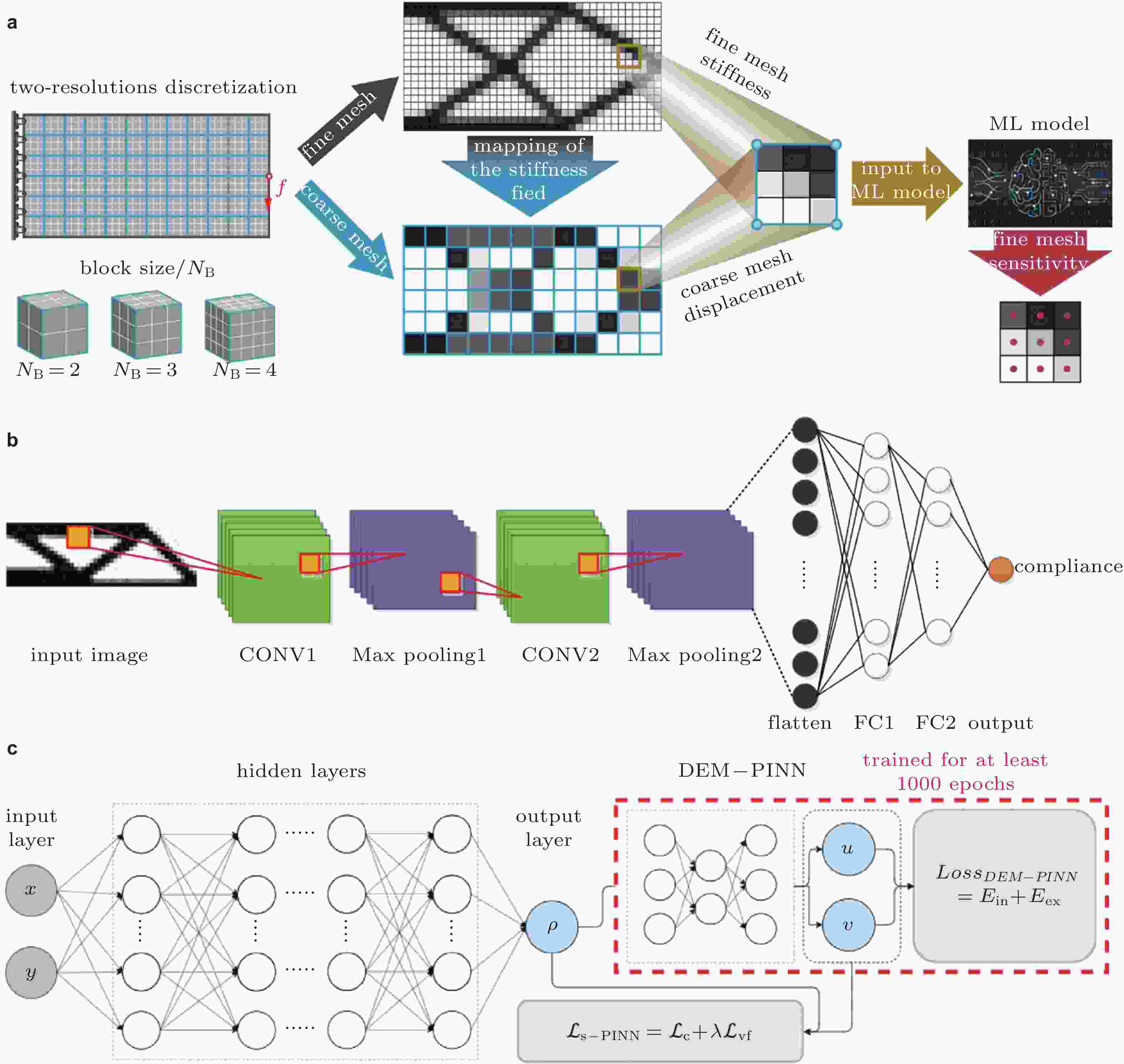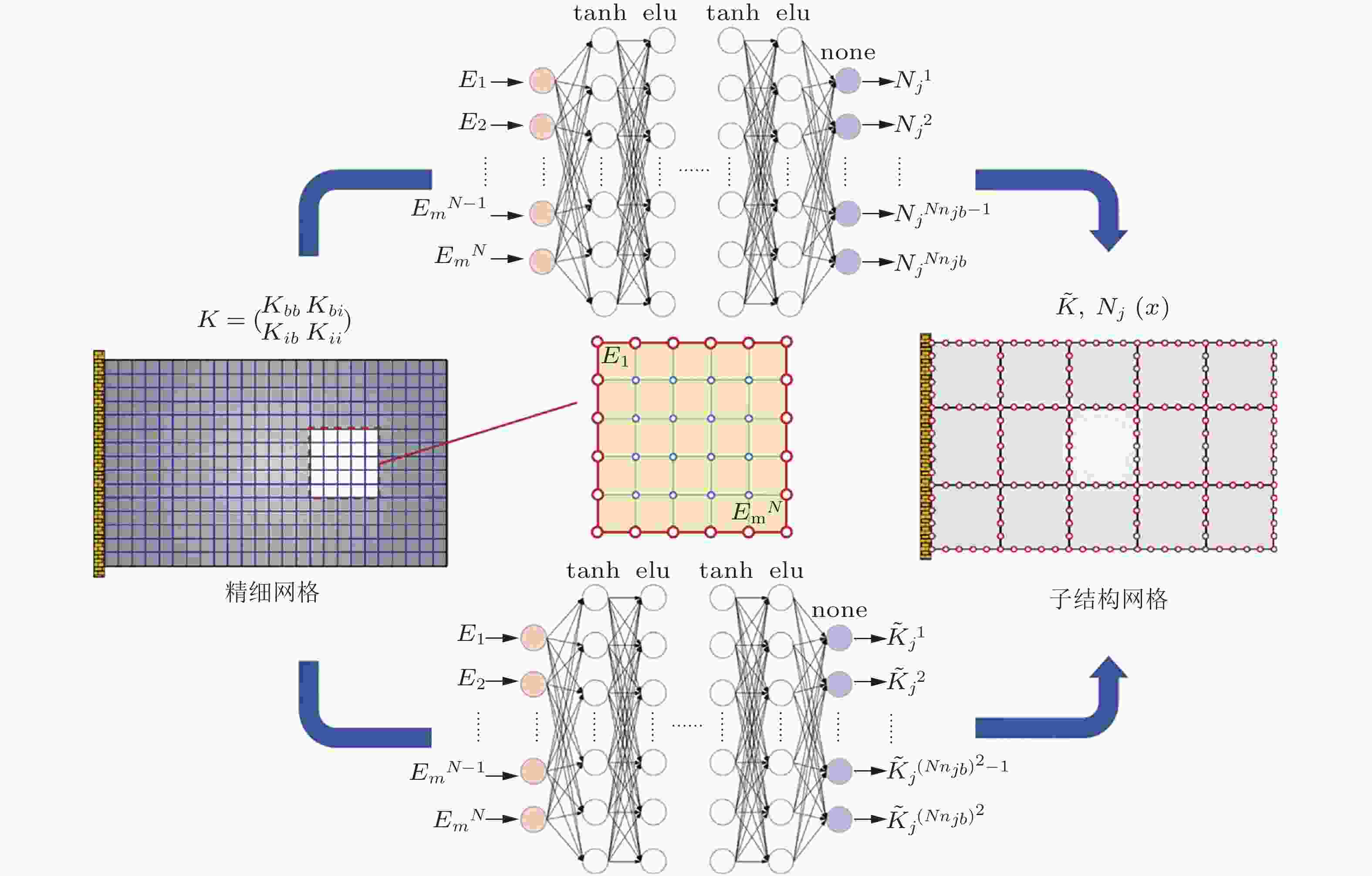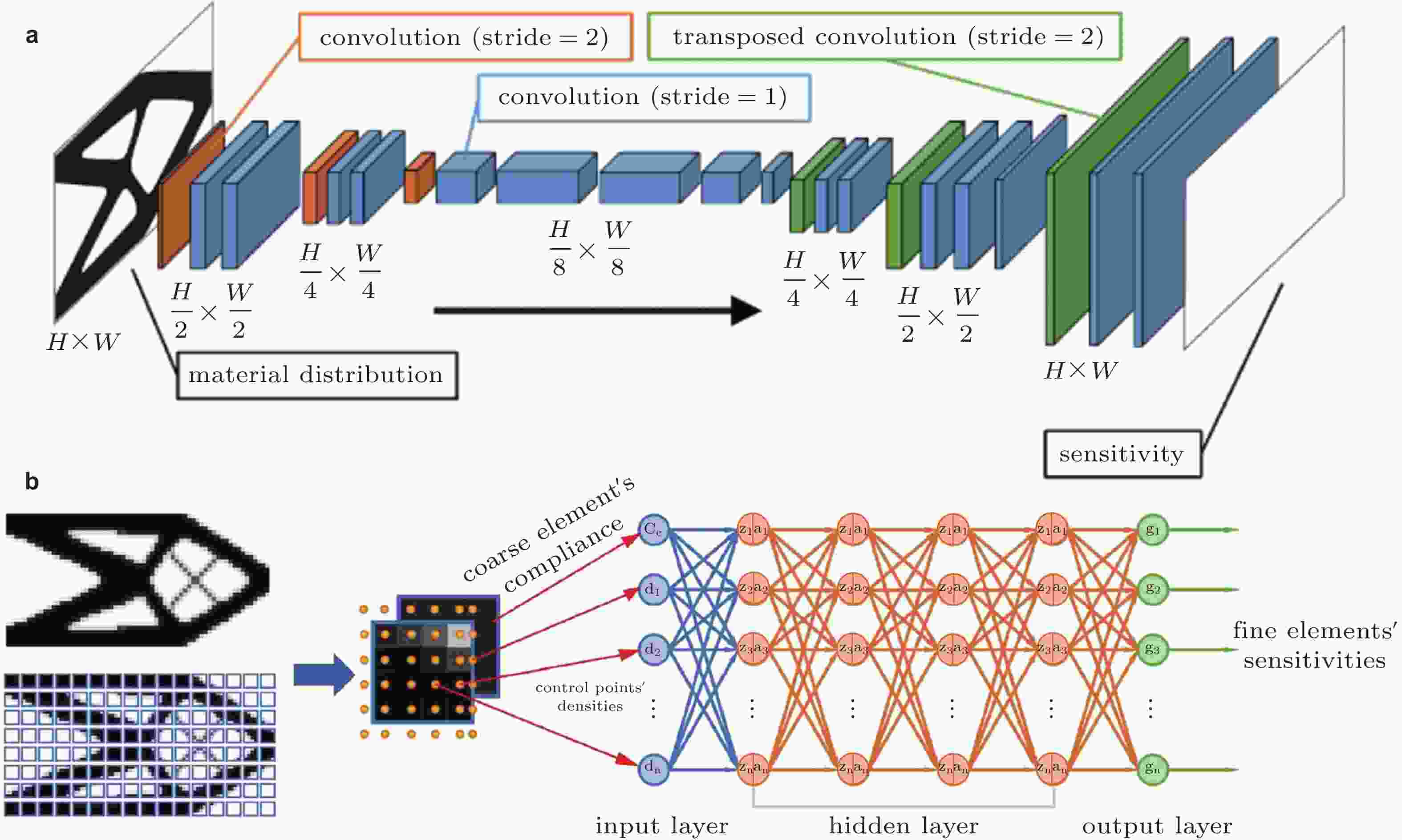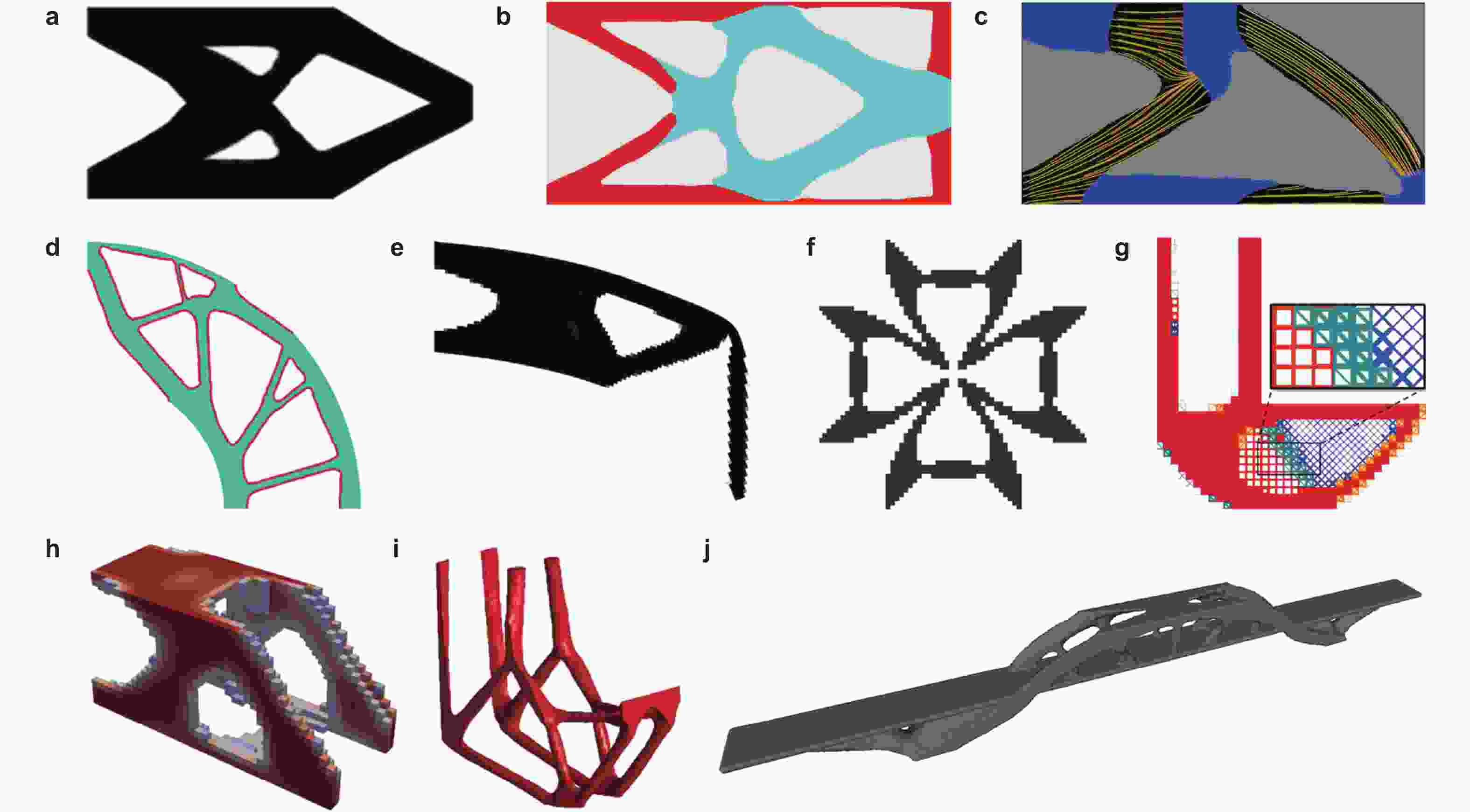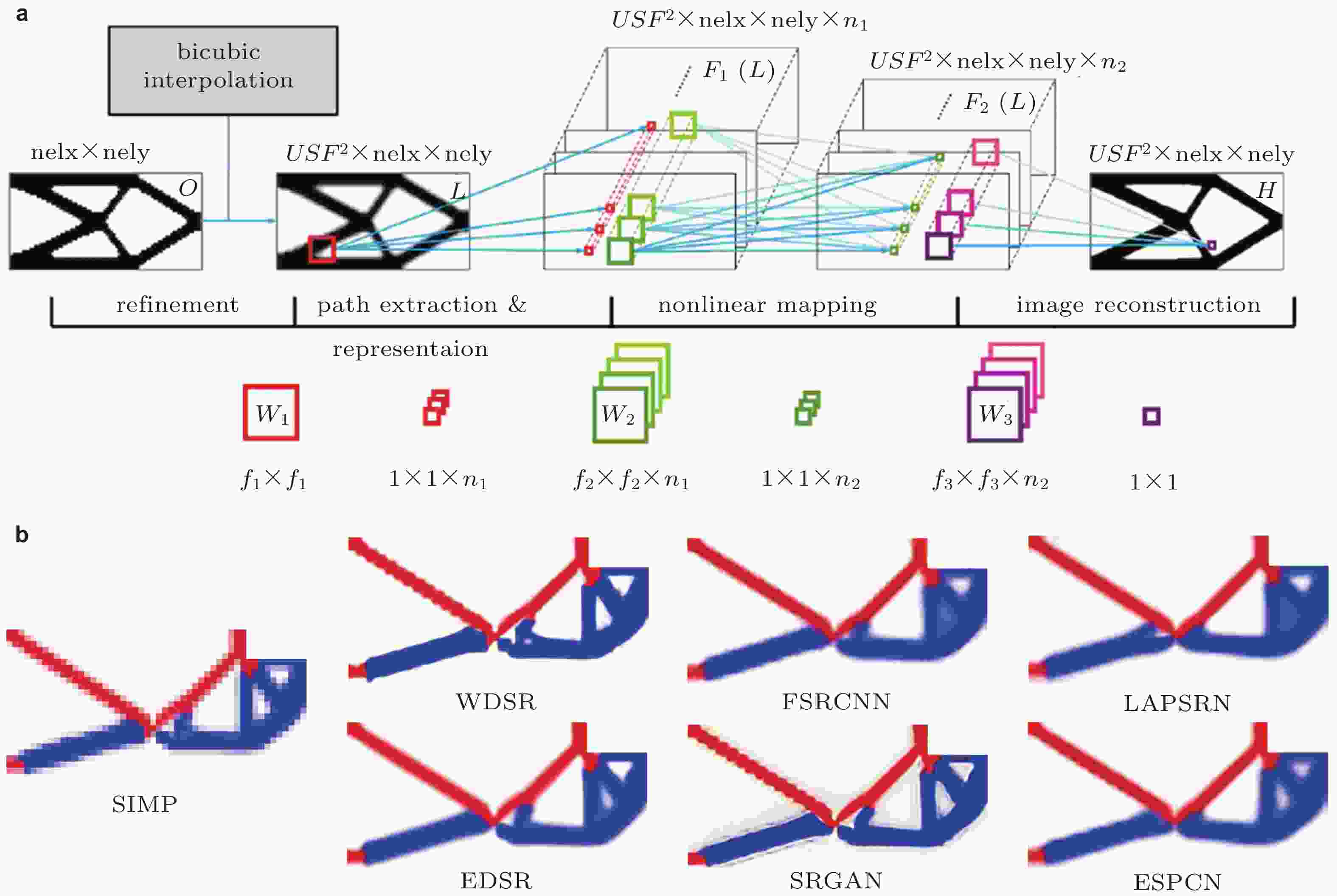Research on structure topology optimization design empowered by deep learning method
-
摘要: 本文综合论述了近年来结构拓扑优化领域与深度学习技术交叉融合发展的相关研究进展. 围绕结构拓扑优化设计的核心方法与关键环节, 从深度学习赋能的角度系统性梳理了两大类赋能方法. 研究指出, 基于深度学习技术的结构优化设计全局代理模型构建方法作为一种直接映射式结构设计方法, 因其简单而典型的设计思想目前已被广泛研究, 然而全局代理模型在计算性和泛化性上的局限与不足也尤为明显; 融合深度学习技术的结构优化设计局部子环节加速与替代方法是一种更加灵活与多样的局部赋能形式, 具有较好的普适性和独特的优越性. 文章对智能赋能结构优化未来的发展进行了展望, 研究重点在于深度学习与结构设计的有机结合方式, 以及数据和知识的混合驱动设计范式.Abstract: This article comprehensively discusses the relevant research progress in the field of structural topology optimization and the cross-integration development of deep learning technology in recent years. Focusing on the core methods and key modules of structural topology optimization design, two major types of empowerment methods are systematically sorted out from the perspective of deep learning empowerment. The study points out that the global surrogate model construction method for structural optimization design based on deep learning technology, as a direct mapping structural design method, has been widely studied because of its simple and typical design ideas. However, the global surrogate model has limitations in computation and generalization. The limitations and deficiencies in performance are also particularly obvious. The structural optimization design method with local sub-link acceleration and replacement integrated with deep learning technology is a more flexible and diverse form of local empowerment, with good universality and unique advantages. The article looks forward to the future development of intelligently empowered structural optimization. Further research work would focus on the organic combination of deep learning and structural design, as well as the co-driven design paradigm of data and knowledge.
-
Key words:
- topology optimization /
- deep learning /
- artificial neural network /
- surrogate model
-
图 2 结构拓扑优化在航空航天、汽车、建筑设计等领域中的典型工程应用. (a) 星敏相机支架设计(Orme et al. 2017), (b) 机翼设计(Aage et al. 2017), (c) 轮毂设计(Zhang et al. 2021b), (d) 机舱铰链支架设计(Tomlin and Meyer 2011), (e) 机舱结构保形设计(Zhu et al. 2016), (f) 斗拱结构设计(Duan et al. 2023), (g) 喷气发动机支架设计(Senhora et al. 2022b)
图 8 典型基于回归式模型构建的拓扑优化代理模型(Nakamura & Suzuki 2020). 以无迭代拓扑优化为例, 代理模型输入通常包含设计域信息、边界条件和载荷条件, 输出为优化后的结构拓扑. 通常回归式模型基于经典CNN网络——U-Net(Ronneberger et al. 2015)构建
图 9 典型基于生成式模型构建的拓扑优化代模型(Nie et al. 2021). 生成器G用于生成多样式的结构拓扑, 判别器D用于判断该结构拓扑“真”与“假”. 训练完成后生成器能够生成与真实拓扑高度相似的拓扑结构
图 10 深度学习技术与拓扑优化物理响应分析结合的三类形式. (a)基于多分辨率思想的大规模结构分析计算加速(Senhora et al. 2022a), (b)构建近实时物理响应分析代理模型(Lee et al. 2020), (c)引入内嵌物理知识神经网络替代有限元法(Jeong et al. 2023b)
图 11 基于子结构法的PIML(Huang et al. 2023)框架. 借助子结构法或EMsFEM思想能够在粗网格下实现细网格的分析精度, 从而大幅减少方程组求解自由度. 但在线生成粗网格单元数值基函数同样是非常耗时的. 已有研究表明: 这部分操作导致的额外计算时间可能使得方法效率优势显著降低甚至消失殆尽. 基于神经网络构建粗网格数值基函数代理模型实时计算数值基函数, 实现EMsFEM粗网格刚度阵或子结构边界刚度阵的快速生成
图 12 PINN框架示意图(Lu et al. 2021b). 其原理可以概括为: 通过训练神经网络最小化损失函数近似PDE求解, 损失函数项包括初始和边界条件的残差项, 以及区域中选定点 (对应于传统数值方法中的“配点”概念) 处的PDE残差. 在训练完成后即可得到任意一点处的响应值
图 13 采用PINN替代有限元分析的拓扑优化. (a)典型的双网络架构, 其中密度网络采用重参数化思想(Zhang et al. 2021c, 2023b)用于表征结构拓扑, 位移网络用于结构物理响应分析(Joglekar et al. 2023); (b) PINN TO(Jeong et al. 2023a)方法3D悬臂梁优化结果, (c) DMF-TONN (Joglekar et al. 2023)方法3D悬臂梁优化结果, (d) CPINN TO (Jeong et al. 2023b)方法3D悬臂梁优化结果, (e) NTopo (Zehnder et al. 2021)方法3D悬臂梁优化结果, (f) (He et al. 2022)方法3D桥状结构优化
图 14 深度学习应用于拓扑优化灵敏度分析环节的两类典型技术路线. (a)构建近实时灵敏度分析代理模型(Takahashi et al. 2019), (b)基于多分辨率思想的精细结构灵敏度快速生成模型(Xia et al. 2023)
图 15 神经网络重参数化方法. 典型的重参数化建模正向计算流程可分为四个环节(Zhang et al. 2021c, 2023b): 结构拓扑的神经网络表征 (neural representations), 设计模型向分析模型映射 (mapping)、物理响应分析 (physics model)、目标函数及约束计算 (objective function). 反向过程即为灵敏度分析
图 16 采用重参数化方法的优化结果. (a)结构刚度设计(Chandrasekhar & Suresh 2021a), (b)多材料设计(Chandrasekhar & Suresh 2021b); (c)纤维连续增强结构设计(Chandrasekhar et al. 2023a); (d)复杂设计域设计(Zhang et al. 2023b); (e)超弹性结构设计(Zhang et al. 2021c); (f)微结构设计(Sridhara et al. 2022); (g)功能梯度结构设计(Chandrasekhar et al. 2023b); (h)三维结构设计(Chen et al. 2023a); (i)应力约束设计(Deng & To 2020); (j)大跨径桥梁结构设计(Qian et al. 2022)
图 17 基于神经网络的拓扑结构超分辨率设计. (a)典型超分辨率设计流程(Xue et al. 2021), (b)超分辨率设计效果, SIMP结果为代表原始低分辨设计, 其它为采用不同神经网络架构得到的超分辨率设计结果, 结构清晰度得到显著提升(Lee et al. 2023)
图 18 典型在线训练流程图(Xia et al. 2023). 蓝色模块对应的迭代步进行数据收集, 黄色模块对应的迭代步进行代理模型的初始训练以及调整, 橙色模块对应的迭代步应用代理模型
-
[1] 陈小前, 姚雯, 赵勇. 2023a. 飞行器多学科设计优化理论与应用研究. 2版. 北京: 国防工业出版社. [2] 陈小前, 赵勇, 霍森林, 等. 2023b. 多尺度结构拓扑优化设计方法综述. 航空学报, 44 (15): 1–36 (Chen X Q, Zhao Y, Huo S L, et al. 2023. A review of topology optimization design methods for multi-scale structures. Acta Aeronautica et Astronautica Sinica, 44 (15), 528863).Chen X Q, Zhao Y, Huo S L, et al. 2023. A review of topology optimization design methods for multi-scale structures. Acta Aeronautica et Astronautica Sinica, 44(15), 528863 [3] 阎军, 许琦, 张起, 等. 2021. 人工智能在结构拓扑优化领域的现状与未来趋势. 计算力学学报, 38(4): 412-422 (Yan J, Xu Q, Zhang Q, et al. 2021. Current and future trends of artificial intelligence in the field of structural topology optimization. Chinese Journal of Computational Mechanics, 38(4): 412-422). doi: 10.7511/jslx20210517401Yan J, Xu Q, Zhang Q, et al. 2021. Current and future trends of artificial intelligence in the field of structural topology optimization. Chinese Journal of Computational Mechanics, 38(4): 412-422. doi: 10.7511/jslx20210517401 [4] 张洪武, 吴敬凯, 刘辉, 等. 2010. 扩展的多尺度有限元法基本原理. 计算机辅助工程, 19(2): 3-9 (Zhang H W, Wu J K, Liu H, et al. 2010. Basic theory of extended multiscale finite element method. Computer Aided Engineering, 19(2): 3-9). doi: 10.3969/j.issn.1006-0871.2010.02.002Zhang H W, Wu J K, Liu H, et al. 2010. Basic theory of extended multiscale finite element method. Computer Aided Engineering, 19(2): 3-9. doi: 10.3969/j.issn.1006-0871.2010.02.002 [5] 张泽雨. 2020. 超弹性体的结构拓扑优化方法研究. 长沙: 国防科技大学. [6] Aage N, Andreassen E, Lazarov B S, et al. 2017. Giga-voxel computational morphogenesis for structural design. Nature, 550(7674): 84-86. doi: 10.1038/nature23911 [7] Abueidda D W, Koric S, Sobh N A. 2020. Topology optimization of 2D structures with nonlinearities using deep learning. Computers & Structures, 237: 106283. [8] Adeli H, Park H S. 1995. A neural dynamics model for structural optimization—theory. Computers & Structures, 57(3): 383-390. [9] Allaire G, Jouve F, Toader A M. 2004. Structural optimization using sensitivity analysis and a Level-set Method. Journal of Computational Physics, 194(1): 363-393. doi: 10.1016/j.jcp.2003.09.032 [10] Almasri W, Bettebghor D, Ababsa F, et al. 2021. Deep learning architecture for topological optimized mechanical design generation with complex shape criterion. Springer International Publishing: 222–234. [11] Almasri W, Bettebghor D, Adjed F, et al. 2022a. Geometrically-driven generation of mechanical designs through deep convolutional GANs. Engineering Optimization, 56(1): 18-35. [12] Almasri W, Danglade F, Bettebghor D, et al. 2022b. Deep learning for additive manufacturing-driven topology optimization. Procedia CIRP, 109: 49-54. doi: 10.1016/j.procir.2022.05.317 [13] Amir O, Bendsøe M P, Sigmund O. 2009. Approximate reanalysis in topology optimization. International Journal for Numerical Methods in Engineering, 78(12): 1474-1491. doi: 10.1002/nme.2536 [14] Amroune A, Cuillière J C, François V. 2022. Automated lofting-based reconstruction of CAD models from 3D topology optimization results. Computer-Aided Design, 145: 103183. doi: 10.1016/j.cad.2021.103183 [15] Andreassen E, Clausen A, Schevenels M, et al. 2011. Efficient topology optimization in MATLAB using 88 lines of code. Structural and Multidisciplinary Optimization, 43(1): 1-16. doi: 10.1007/s00158-010-0594-7 [16] Asanuma J, Doi S, Igarashi H. 2020. Transfer learning through deep learning: application to topology optimization of electric motor. IEEE Transactions on Magnetics, 56 (3): 1–4. [17] Ates G C, Gorguluarslan R M. 2021. Two-stage convolutional encoder-decoder network to improve the performance and reliability of deep learning models for topology optimization. Structural and Multidisciplinary Optimization, 63(4): 1927-1950. doi: 10.1007/s00158-020-02788-w [18] Aulig N, Olhofer M. 2014. Topology optimization by predicting sensitivities based on local state features. [19] Banga S, Gehani H, Bhilare S, et al. 2018. 3D topology optimization using convolutional neural networks. arXiv: 1808.07440. [20] Bastek J H, Kumar S, Telgen B, et al. 2022. Inverting the structure–property map of truss metamaterials by deep learning. Proceedings of the National Academy of Sciences of the United States of America, 119(1): e2111505119. [21] Baydin A G, Pearlmutter B A, Radul A A, et al. 2018. Automatic differentiation in machine learning: a survey. Journal of Machine Learning Research, 18(153): 43. [22] Behzadi M M, Ilieş H T. 2022. GANTL: Towards practical and real-time topology optimization with conditional GANs and transfer learning. Journal of Mechanical Design, 144 : 1–32. [23] Behzadi M M, Ilieş H T. 2021. Real-time topology optimization in 3D via deep transfer learning. Computer-Aided Design, 135: 103014. doi: 10.1016/j.cad.2021.103014 [24] Bellman R. 1961. Adaptive Control Processes. New Jersey: Princeton University Press. [25] Benbarka N, Höfer T, Riaz H ul-moqeet, et al. 2021. Seeing implicit neural representations as fourier series: arXiv: 2109.00249. [26] Bendsøe M P, Kikuchi N. 1988. Generating optimal topologies in structural design using a homogenization method. Computer Methods in Applied Mechanics and Engineering, 71(2): 197-224. doi: 10.1016/0045-7825(88)90086-2 [27] Bendsøe M P, Sigmund O. 1999. Material interpolation schemes in topology optimization. Archive of Applied Mechanics, 69(9-10): 635-654. doi: 10.1007/s004190050248 [28] Bendsøe M P, Sigmund O. 2011. Topology optimization: theory, methods, and applications. Berlin Heidelberg: Springer. [29] Berke L, Hajela P. 1992. Applications of artificial neural nets in structural Mechanics. Structural Optimization, 4(2): 90-98. doi: 10.1007/BF01759922 [30] Bi S, Zhang J, Zhang G. 2020. Scalable deep-learning-accelerated topology optimization for additively manufactured materials. arXiv: 2011.14177. [31] Bielecki D, Patel D, Rai R, et al. 2021. Multi-stage deep neural network accelerated topology optimization. Structural and Multidisciplinary Optimization, 64(6): 3473-3487. doi: 10.1007/s00158-021-03028-5 [32] Black N, Najafi A R. 2023. Deep neural networks for parameterized homogenization in concurrent multiscale structural optimization. Structural and Multidisciplinary Optimization, 66(1): 20. doi: 10.1007/s00158-022-03471-y [33] Bruyneel M, Colson B, Remouchamps A. 2008. Discussion on some convergence problems in buckling optimisation. Structural and Multidisciplinary Optimization, 35(2): 181-186. doi: 10.1007/s00158-007-0129-z [34] Chan Y C, Da D, Wang L, et al. 2022. Remixing functionally graded structures: data-driven topology optimization with multiclass shape blending. Structural and Multidisciplinary Optimization, 65(5): 135. doi: 10.1007/s00158-022-03224-x [35] Chandrasekhar A, Mirzendehdel A, Behandish M, et al. 2023. FRC-TOuNN: topology optimization of continuous fiber reinforced composites using neural network. Computer-Aided Design, 156: 103449. doi: 10.1016/j.cad.2022.103449 [36] Chandrasekhar A, Sridhara S, Suresh K. 2021. AuTO: a framework for automatic differentiation in topology optimization. Structural and Multidisciplinary Optimization, 64(6): 4355-4365. doi: 10.1007/s00158-021-03025-8 [37] Chandrasekhar A, Sridhara S, Suresh K. 2022. Integrating material selection with design optimization via neural networks. Engineering with Computers, 38(5): 4715-4730. doi: 10.1007/s00366-022-01736-0 [38] Chandrasekhar A, Sridhara S, Suresh K. 2023. Graded multiscale topology optimization using neural networks. Advances in Engineering Software, 175: 103359. doi: 10.1016/j.advengsoft.2022.103359 [39] Chandrasekhar A, Suresh K. 2021a. TOuNN: topology optimization using neural networks. Structural and Multidisciplinary Optimization, 63(3): 1135-1149. doi: 10.1007/s00158-020-02748-4 [40] Chandrasekhar A, Suresh K. 2021b. Multi-material topology optimization using neural networks. Computer-Aided Design, 136: 103017. doi: 10.1016/j.cad.2021.103017 [41] Chandrasekhar A, Suresh K. 2022. Approximate length scale filter in topology optimization using fourier enhanced neural networks. Computer-Aided Design, 150: 103277. doi: 10.1016/j.cad.2022.103277 [42] Chen H, Joglekar A, Whitefoot K S, et al. 2023a. Concurrent build direction, part segmentation, and topology optimization for additive manufacturing using neural networks. Journal of Mechanical Design, 145(9): 091702. doi: 10.1115/1.4062663 [43] Chen X, Yao W, Zhou W, et al. 2023b. A general differentiable layout optimization framework for heat transfer problems. International Journal of Heat and Mass Transfer, 211: 124205. doi: 10.1016/j.ijheatmasstransfer.2023.124205 [44] Chen X Q, Zhao X, Gong Z, et al. 2021. A deep neural network surrogate modeling benchmark for temperature field prediction of heat source layout. Science China-Physics Mechanics & Astronomy, 64(11): 1. [45] Cheng K T, Olhoff N. 1981. An investigation concerning optimal design of solid elastic plates. International Journal of Solids and Structures, 17(3): 305-323. doi: 10.1016/0020-7683(81)90065-2 [46] Cheon S, Cho H. 2023. Comparative study on manifold learning approaches for parametric topology optimization problem via unsupervised deep learning. Optimization and Engineering. [47] Chi H, Zhang Y, Tang T L E, et al. 2021. Universal machine learning for topology optimization. Computer Methods in Applied Mechanics and Engineering, 375: 112739. doi: 10.1016/j.cma.2019.112739 [48] Chu S, Xiao M, Gao L, et al. 2016. An effective structural boundary processing method based on support vector machine for discrete topology optimization. 2016 IEEE 20th International Conference on Computer Supported Cooperative Work in Design (CSCWD). Nanchang, China: IEEE: 10–15. [49] Cybenko G. 1989. Approximation by superpositions of a sigmoidal function. Mathematics of Control, Signals, and Systems, 2(4): 303-314. doi: 10.1007/BF02551274 [50] Deng H, To A C. 2020. Topology optimization based on deep representation learning (DRL) for compliance and stress-constrained design. Computational Mechanics, 66(2): 449-469. doi: 10.1007/s00466-020-01859-5 [51] Deng H, To A C. 2021. A parametric level set method for topology optimization based on deep neural network. Journal of Mechanical Design, 143(9): 091702. doi: 10.1115/1.4050105 [52] Deng C, Wang Y, Qin C, et al. 2022. Self-directed online machine learning for topology optimization. Nature Communications, 13(1): 388. doi: 10.1038/s41467-021-27713-7 [53] Dilgen C B, Dilgen S B, Fuhrman D R, et al. 2018. Topology optimization of turbulent flows. Computer Methods in Applied Mechanics and Engineering, 331: 363-393. doi: 10.1016/j.cma.2017.11.029 [54] Dilgen S B, Dilgen C B, Fuhrman D R, et al. 2018. Density based topology optimization of turbulent flow heat transfer systems. Structural and Multidisciplinary Optimization, 57(5): 1905-1918. doi: 10.1007/s00158-018-1967-6 [55] Dondorp M E. 2016. GPU Computing for topology optimization. Delft: Delft University of Technology. [56] Dosovitskiy A, Brox T. 2016. Inverting visual representations with convolutional networks. 2016 IEEE Conference on Computer Vision and Pattern Recognition (CVPR). Las Vegas, NV, USA: IEEE: 4829–4837. [57] Du Z, Ding X, Chen H, et al. 2022. Optimal design of topological waveguides by machine learning. Frontiers in Materials, 9: 1075073. doi: 10.3389/fmats.2022.1075073 [58] Du Z, Luo J, Xu Z, et al. 2023. Higher-order topological insulators by ML-enhanced topology optimization. International Journal of Mechanical Sciences, 255: 108441. doi: 10.1016/j.ijmecsci.2023.108441 [59] Du B, Zhao Y, Yao W, et al. 2020. Multiresolution isogeometric topology optimisation using moving morphable voids. CMES-Computer Modeling in Engineering & Sciences, 122(3): 1119-1140. [60] Duan C B, Shen S Y, Bao D W, et al. 2023. Innovative design solutions for contemporary Tou-Kung based on topological optimisation. Architectural Intelligence, 2(1): 10. doi: 10.1007/s44223-023-00028-x [61] Dupuis B, Jacot A. 2021. DNN-based topology optimisation: Spatial invariance and neural tangent kernel. Advances in neural information processing systems. Curran Associates, Inc. : 27659–27669. [62] Elingaard M O, Aage N, Bærentzen J A, et al. 2022. De-homogenization using convolutional neural networks. Computer Methods in Applied Mechanics and Engineering, 388: 114197. doi: 10.1016/j.cma.2021.114197 [63] Freitag S, Peters S, Edler P, et al. 2022. Reliability-based optimization of structural topologies using artificial neural networks. Probabilistic Engineering Mechanics, 70: 103356. doi: 10.1016/j.probengmech.2022.103356 [64] Gao J, Xiao M, Zhang Y, et al. 2020. A comprehensive review of isogeometric topology optimization: Methods, applications and prospects. Chinese Journal of Mechanical Engineering, 33(1): 87. doi: 10.1186/s10033-020-00503-w [65] Geng D, Yan J, Xu Q, et al. 2023. Real-Time structure topology optimization using CNN driven moving morphable component method. Engineering Structures, 290: 116376. doi: 10.1016/j.engstruct.2023.116376 [66] Goodfellow I, Bengio Y, Courville A. 2016. Deep learning. Cambridge, Massachusetts: MIT Press. [67] Goodfellow I, Pouget-Abadie J, Mirza M, et al. 2014. Generative adversarial nets. Proceedings of the 27th International Conference on Neural Information Processing Systems - Volume 2. Montreal, Canada: MIT Press: 2672–2680. [68] Groen J P, Sigmund O. 2018. Homogenization-based topology optimization for high-resolution manufacturable microstructures. International Journal for Numerical Methods in Engineering, 113(8): 1148-1163. doi: 10.1002/nme.5575 [69] Gropp A, Yariv L, Haim N, et al. 2020. Implicit geometric regularization for learning shapes. Proceedings of the 37th international conference on machine learning. PMLR: 3789–3799. [70] Grossmann T G, Komorowska U J, Latz J, et al. 2023. Can physics-informed neural networks beat the finite element method? arXiv: 2302.04107. [71] Guo T, Lohan D J, Cang R, et al. 2018. An indirect design representation for topology optimization using variational autoencoder and style transfer. 2018 AIAA/ASCE/AHS/ASC Structures, Structural Dynamics, and Materials Conference. Kissimmee, Florida: American Institute of Aeronautics and Astronautics. [72] Guo X, Zhang W, Zhong W. 2014. Doing topology optimization explicitly and geometrically—a new moving morphable components based framework. Journal of Applied Mechanics-Transactions of the ASME, 81(8): 081009. doi: 10.1115/1.4027609 [73] Haghighat E, Raissi M, Moure A, et al. 2021. A physics-informed deep learning framework for inversion and surrogate modeling in solid mechanics. Computer Methods in Applied Mechanics and Engineering, 379: 113741. doi: 10.1016/j.cma.2021.113741 [74] Hajela P, Berke L. 1991. Neurobiological computational models in structural analysis and design. Computers & Structures, 41(4): 657-667. [75] Halle A, Campanile L F, Hasse A. 2021. An artificial intelligence–assisted design method for topology optimization without pre-optimized training data. Applied Sciences-Basel, 11(19): 9041. doi: 10.3390/app11199041 [76] He J, Chadha C, Kushwaha S, et al. 2022. Deep energy method in topology optimization applications. Acta Mechanica, 234(4): 1365-1379. [77] He J, Koric S, Kushwaha S, et al. 2023. Novel DeepONet architecture to predict stresses in elastoplastic structures with variable complex geometries and loads. Computer Methods in Applied Mechanics and Engineering, 415: 116277. doi: 10.1016/j.cma.2023.116277 [78] Herath S, Haputhanthri U. 2021. Topologically optimal design and failure prediction using conditional generative adversarial networks. International Journal for Numerical Methods in Engineering, 122(23): 6867-6887. doi: 10.1002/nme.6814 [79] Herrero-Pérez D, Martínez Castejón P J. 2021. Multi-GPU acceleration of large-scale density-based topology optimization. Advances in Engineering Software, 157–158 : 103006. [80] Hertlein N, Buskohl P R, Gillman A, et al. 2021. Generative adversarial network for early-stage design flexibility in topology optimization for additive manufacturing. Journal of Manufacturing Systems, 59: 675-685. doi: 10.1016/j.jmsy.2021.04.007 [81] Hoang V N, Nguyen N L, Tran D Q, et al. 2022. Data-driven geometry-based topology optimization. Structural and Multidisciplinary Optimization, 65(2): 69. doi: 10.1007/s00158-022-03170-8 [82] Hornik K. 1991. Approximation capabilities of multilayer feedforward networks. Neural Networks, 4(2): 251-257. doi: 10.1016/0893-6080(91)90009-T [83] Hoyer S, Sohl-Dickstein J, Greydanus S. 2019. Neural reparameterization improves structural optimization. arXiv: 1909.04240. [84] Huang Z, Bai S, Kolter J Z. 2021. (Implicit)2 : Implicit layers for implicit representations. Advances in neural information processing systems. Curran Associates, Inc. : 9639–9650. [85] Huang M, Cui T, Liu C, et al. 2023. A problem-independent machine learning (PIML) enhanced substructure-based approach for large-scale structural analysis and topology optimization of linear elastic structures. Extreme Mechanics Letters, 63: 102041. doi: 10.1016/j.eml.2023.102041 [86] Huang M, Du Z, Liu C, et al. 2022. Problem-independent machine learning (PIML)-based topology optimization—a universal approach. Extreme Mechanics Letters, 56: 101887. doi: 10.1016/j.eml.2022.101887 [87] Islam M M, Liu L. 2022. Deep learning accelerated topology optimization with inherent control of image quality. Structural and Multidisciplinary Optimization, 65(11): 325. doi: 10.1007/s00158-022-03433-4 [88] Iyer N S, Mirzendehdel A M, Raghavan S, et al. 2021. PATO: producibility-aware topology optimization using deep learning for metal additive manufacturing: arXiv: 2112.04552. [89] Jeong H, Bai J, Batuwatta-Gamage C P, et al. 2023. A physics-informed neural network-based topology optimization (PINNTO) framework for structural optimization. Engineering Structures, 278: 115484. doi: 10.1016/j.engstruct.2022.115484 [90] Jeong H, Batuwatta-Gamage C, Bai J, et al. 2023. A complete physics-Informed neural network-based framework for structural topology optimization. Computer Methods in Applied Mechanics and Engineering, 417: 116401. doi: 10.1016/j.cma.2023.116401 [91] Joglekar A, Chen H, Kara L B. 2023. DMF-TONN: direct mesh-free topology optimization using neural networks. Engineering with Computers. [92] Jung J, Yoon K, Lee P S. 2020. Deep learned finite elements. Computer Methods in Applied Mechanics and Engineering, 372: 113401. doi: 10.1016/j.cma.2020.113401 [93] Kallioras N Ath, Kazakis G, Lagaros N D. 2020. Accelerated topology optimization by means of deep learning. Structural and Multidisciplinary Optimization, 62(3): 1185-1212. doi: 10.1007/s00158-020-02545-z [94] Kallioras N Ath, Lagaros N D. 2021a. DL-SCALE: a novel deep learning-based model order upscaling scheme for solving topology optimization problems. Neural Computing & Applications, 33(12): 7125-7144. [95] Kallioras N Ath, Lagaros N D. 2021b. MLGen: generative design framework based on machine learning and topology optimization. Applied Sciences-Basel, 11(24): 12044. doi: 10.3390/app112412044 [96] Kallioras N Ath, Nordas A N, Lagaros N D. 2021. Deep learning-based accuracy upgrade of reduced order models in topology optimization. Applied Sciences-Basel, 11(24): 12005. doi: 10.3390/app112412005 [97] Karniadakis G E, Kevrekidis I G, Lu L, et al. 2021. Physics-informed machine learning. Nature Reviews Physics, 3(6): 422-440. doi: 10.1038/s42254-021-00314-5 [98] Kazemi H, Seepersad C, Kim H A. 2022. Topology optimization integrated deep learning for multiphysics problems. AIAA SCITECH 2022 Forum. San Diego, CA & Virtual: American Institute of Aeronautics and Astronautics. [99] Keshavarzzadeh V, Alirezaei M, Tasdizen T, et al. 2021. Image-based multiresolution topology optimization using deep disjunctive normal shape model. Computer-Aided Design, 130: 102947. doi: 10.1016/j.cad.2020.102947 [100] Keshavarzzadeh V, Kirby R M, Narayan A. 2021. Robust topology optimization with low rank approximation using artificial neural networks. Computational Mechanics, 68(6): 1297-1323. doi: 10.1007/s00466-021-02069-3 [101] Kim C, Lee J, Yoo J. 2021. Machine learning-combined topology optimization for functionary graded composite structure design. Computer Methods in Applied Mechanics and Engineering, 387: 114158. doi: 10.1016/j.cma.2021.114158 [102] Kim K H, Yoon G H. 2022. Acoustic topology optimization using moving morphable components in neural network-based design. Structural and Multidisciplinary Optimization, 65(2): 47. doi: 10.1007/s00158-021-03137-1 [103] Kirchdoerfer T, Ortiz M. 2016. Data-driven computational mechanics. Computer Methods in Applied Mechanics and Engineering, 304: 81-101. doi: 10.1016/j.cma.2016.02.001 [104] Kodiyalam S, Gurumoorthy R. 1996. Neural networks with modified backpropagation learning applied to structural optimization. AIAA Journal, 34(2): 408-412. doi: 10.2514/3.13078 [105] Krizhevsky A, Sutskever I, Hinton G E. 2017. ImageNet classification with deep convolutional neural networks. Communications of the ACM, 60(6): 84-90. doi: 10.1145/3065386 [106] Kudela P, Ijjeh A, Radzienski M, et al. 2023. Deep learning aided topology optimization of phononic crystals. Mechanical Systems and Signal Processing, 200: 110636. doi: 10.1016/j.ymssp.2023.110636 [107] Lagaros N D, Charmpis D C, Papadrakakis M. 2005. An adaptive neural network strategy for improving the computational performance of evolutionary structural optimization. Computer Methods in Applied Mechanics and Engineering, 194(30-33): 3374-3393. doi: 10.1016/j.cma.2004.12.023 [108] Lecun Y, Bengio Y, Hinton G. 2015. Deep learning. Nature, 521(7553): 436-444. doi: 10.1038/nature14539 [109] Lecun Y, Bottou L, Bengio Y, et al. 1998. Gradient-based learning applied to document recognition. Proceedings of the IEEE, 86(11): 2278-2324. doi: 10.1109/5.726791 [110] Lee S, Kim H, Lieu Q X, et al. 2020. CNN-based image recognition for topology optimization. Knowledge-Based Systems, 198: 105887. doi: 10.1016/j.knosys.2020.105887 [111] Lee S, Lieu Q X, Vo T P, et al. 2023. Topology optimization using super-resolution image reconstruction methods. Advances in Engineering Software, 177: 103413. doi: 10.1016/j.advengsoft.2023.103413 [112] Li B, Huang C, Li X, et al. 2019. Non-iterative structural topology optimization using deep learning. Computer-Aided Design, 115: 172-180. doi: 10.1016/j.cad.2019.05.038 [113] Li K, Ye W, Gao Y. 2023. A 3D structure mapping-based efficient topology optimization framework. Journal of Mechanical Design, 145(8): 081703. doi: 10.1115/1.4062352 [114] Li J, Ye H, Yuan B, et al. 2022. Cross-resolution topology optimization for geometrical non-linearity by using deep learning. Structural and Multidisciplinary Optimization, 65(4): 133. doi: 10.1007/s00158-022-03231-y [115] Li Y, Ge W, Liu B, et al. 2023. Collaborative optimization of composite structure and fiber orientation through real-time correction of deep neural network (DNN) models with elite samples. Mechanics of Advanced Materials and Structures, 1–13. [116] Lin Q, Hong J, Liu Z, et al. 2018. Investigation into the topology optimization for conductive heat transfer based on deep learning approach. International Communications in Heat and Mass Transfer, 97: 103-109. doi: 10.1016/j.icheatmasstransfer.2018.07.001 [117] Lin C Y, Lin S H. 2005. Artificial neural network based hole image interpretation techniques for integrated topology and shape optimization. Computer Methods in Applied Mechanics and Engineering, 194(36-38): 3817-3837. doi: 10.1016/j.cma.2004.09.005 [118] Liu D, Chiu L N S, Davies C, et al. 2020. A post-processing method to remove stress singularity and minimize local stress concentration for topology optimized designs. Advances in Engineering Software, 145: 102815. doi: 10.1016/j.advengsoft.2020.102815 [119] Liu H, Hu Y, Zhu B, et al. 2018. Narrow-band topology optimization on a sparsely populated grid. ACM Transactions on Graphics, 37(6): 1-14. [120] Liu K, Tovar A, Nutwell E, et al. 2015. Towards nonlinear multimaterial topology optimization using unsupervised machine learning and metamodel-based optimization. Volume 2B: 41st Design Automation Conference. Boston, Massachusetts, USA: American Society of Mechanical Engineers: V02BT03A004. [121] Liu J, Xia Y. 2022. A hybrid intelligent genetic algorithm for truss optimization based on deep neutral network. Swarm and Evolutionary Computation, 73: 101120. doi: 10.1016/j.swevo.2022.101120 [122] Logarzo H J, Capuano G, Rimoli J J. 2021. Smart constitutive laws: inelastic homogenization through machine learning. Computer Methods in Applied Mechanics and Engineering, 373: 113482. doi: 10.1016/j.cma.2020.113482 [123] Lu L, Jin P, Pang G, et al. 2021. Learning nonlinear operators via DeepONet based on the universal approximation theorem of operators. Nature Machine Intelligence, 3(3): 218-229. doi: 10.1038/s42256-021-00302-5 [124] Lu L, Meng X, Mao Z, et al. 2021. DeepXDE: A deep learning library for solving differential equations. SIAM Review, 63(1): 208-228. doi: 10.1137/19M1274067 [125] Lu L, Pestourie R, Yao W, et al. 2021. Physics-informed neural networks with hard constraints for inverse design. SIAM Journal on Scientific Computing, 43(6): B1105-B1132. doi: 10.1137/21M1397908 [126] Luo J, Li Y, Zhou W, et al. 2021. An improved data-driven topology optimization method using feature pyramid networks with physical constraints. CMES-Computer Modeling in Engineering & Sciences, 128(3): 823-848. [127] Ma Q, DeMeter E C, Basu S. 2023. Learning topology optimization process via convolutional long-short-term memory autoencoder-decoder. International Journal for Numerical Methods in Engineering, 124(11): 2571-2588. doi: 10.1002/nme.7221 [128] Ma F, Zeng Z. 2020. High-risk prediction localization: evaluating the reliability of black box models for topology optimization. Structural and Multidisciplinary Optimization, 62(6): 3053-3069. doi: 10.1007/s00158-020-02648-7 [129] Mahendran A, Vedaldi A. 2015. Understanding deep image representations by inverting them. 2015 IEEE Conference on Computer Vision and Pattern Recognition (CVPR). Boston, MA, USA: IEEE: 5188–5196. [130] Mai H T, Kang J, Lee J. 2021. A machine learning-based surrogate model for optimization of truss structures with geometrically nonlinear behavior. Finite Elements in Analysis and Design, 196: 103572. doi: 10.1016/j.finel.2021.103572 [131] Mai H T, Lee S, Kim D, et al. 2023. Optimum design of nonlinear structures via deep neural network-based parameterization framework. European Journal of Mechanics A-Solids, 98: 104869. doi: 10.1016/j.euromechsol.2022.104869 [132] Mai H T, Lieu Q X, Kang J, et al. 2023. A novel deep unsupervised learning-based framework for optimization of truss structures. Engineering with Computers, 39(4): 2585-2608. doi: 10.1007/s00366-022-01636-3 [133] Mai H T, Mai D D, Kang J, et al. 2023. Physics-informed neural energy-force network: a unified solver-free numerical simulation for structural optimization. Engineering with Computers. [134] Mao S, Cheng L, Chen H, et al. 2023. Multi-task topology optimization of photonic devices in low-dimensional fourier domain via deep learning. Nanophotonics, 12(5): 1007-1018. doi: 10.1515/nanoph-2022-0361 [135] Martínez-Frutos J, Herrero-Pérez D. 2016. Large-scale robust topology optimization using multi-GPU systems. Computer Methods in Applied Mechanics and Engineering, 311: 393-414. doi: 10.1016/j.cma.2016.08.016 [136] Meng L, Zhang W, Quan D, et al. 2020. From topology optimization design to additive manufacturing: today’s success and tomorrow’s roadmap. Archives of Computational Methods in Engineering, 27(3): 805-830. doi: 10.1007/s11831-019-09331-1 [137] Michalkiewicz M, Pontes J K, Jack D, et al. 2019. Implicit surface representations as layers in neural networks. 2019 IEEE/CVF International Conference on Computer Vision (ICCV). Seoul, Korea (South): IEEE: 4742–4751. [138] Michell A G M. 1904. LVIII. The limits of economy of material in frame-structures. The London, Edinburgh, and Dublin Philosophical Magazine and Journal of Science, 8(47): 589-597. doi: 10.1080/14786440409463229 [139] Nakamura K, Suzuki Y. 2020. Deep learning-based topological optimization for representing a user-specified design area. arXiv: 2004.05461. [140] Napier N, Sriraman S A, Tran H T, et al. 2020. An artificial neural network approach for generating high-resolution designs from low-resolution input in topology optimization. Journal of Mechanical Design, 142(1): 011402. doi: 10.1115/1.4044332 [141] Nguyen T H, Paulino G H, Song J, et al. 2010. A computational paradigm for multiresolution topology optimization (MTOP). Structural and Multidisciplinary Optimization, 41(4): 525-539. doi: 10.1007/s00158-009-0443-8 [142] Nie Z, Lin T, Jiang H, et al. 2021. TopologyGAN: Topology optimization using generative adversarial networks based on physical fields over the initial domain. Journal of Mechanical Design, 143(3): 031715. doi: 10.1115/1.4049533 [143] Novello T, Schardong G, Schirmer L, et al. 2022. Exploring differential geometry in neural implicits. Computers & Graphics-UK, 108: 49-60. [144] Oh S, Jung Y, Kim S, et al. 2019. Deep generative design: integration of topology optimization and generative models. Journal of Mechanical Design, 141(11): 111405. doi: 10.1115/1.4044229 [145] Oishi A, Yagawa G. 2022. Sustainable computational mechanics assisted by deep learning. Computer Methods in Applied Mechanics and Engineering, 402: 115025. doi: 10.1016/j.cma.2022.115025 [146] Orme M E, Gschweitl M, Ferrari M, et al. 2017. Additive manufacturing of lightweight, optimized, metallic components suitable for space flight. Journal of Spacecraft and Rockets, 54(5): 1050-1059. doi: 10.2514/1.A33749 [147] Ozaki I, Kimura F, Berz M. 1995. Higher-order sensitivity analysis of finite element method by automatic differentiation. Computational Mechanics, 16(4): 223-234. doi: 10.1007/BF00369867 [148] Ozaki I, Terano T. 1993. Applying an automatic differentiation technique to sensitivity analysis in design optimization problems. Finite Elements in Analysis and Design, 14(2-3): 143-151. doi: 10.1016/0168-874X(93)90015-I [149] Papadrakakis M, Lagaros N D. 2002. Reliability-based structural optimization using neural networks and Monte Carlo simulation. Computer Methods in Applied Mechanics and Engineering, 191(32): 3491-3507. doi: 10.1016/S0045-7825(02)00287-6 [150] Papadrakakis M, Lagaros N D, Tsompanakis Y. 1998. Structural optimization using evolution strategies and neural networks. Computer Methods in Applied Mechanics and Engineering, 156(1-4): 309-333. doi: 10.1016/S0045-7825(97)00215-6 [151] Park J J, Florence P, Straub J, et al. 2019. DeepSDF: learning continuous signed distance functions for shape representation. 2019 IEEE/CVF Conference on Computer Vision and Pattern Recognition (CVPR). Long Beach, CA, USA: IEEE: 165–174. [152] Parrott C, Abueidda D, James K A. 2022. Multi-head self-attention gans for multiphysics topology optimization. AIAA AVIATION 2022 Forum. Chicago, IL & Virtual: American Institute of Aeronautics and Astronautics. [153] Patel D, Bielecki D, Rai R, et al. 2022. Improving connectivity and accelerating multiscale topology optimization using deep neural network techniques. Structural and Multidisciplinary Optimization, 65(4): 126. doi: 10.1007/s00158-022-03223-y [154] Qian W, Xu Y, Li H. 2022. A topology description function-enhanced neural network for topology optimization. Computer-Aided Civil and Infrastructure Engineering, 38(8): 1020-1040. [155] Qian C, Ye W. 2021. Accelerating gradient-based topology optimization design with dual-model artificial neural networks. Structural and Multidisciplinary Optimization, 63(4): 1687-1707. doi: 10.1007/s00158-020-02770-6 [156] Qiu C, Du S, Yang J. 2021. A deep learning approach for efficient topology optimization based on the element removal strategy. Materials & Design, 212: 110179. [157] Querin O M, Steven G P, Xie Y M. 1998. Evolutionary structural optimisation (ESO) using a bidirectional algorithm. Engineering Computations, 15(8): 1031-1048. doi: 10.1108/02644409810244129 [158] Rade J, Balu A, Herron E, et al. 2021. Algorithmically-consistent deep learning frameworks for structural topology optimization. Engineering Applications of Artificial Intelligence, 106: 104483. doi: 10.1016/j.engappai.2021.104483 [159] Raissi M, Karniadakis G E. 2018. Hidden physics models: Machine learning of nonlinear partial differential equations. Journal of Computational Physics, 357: 125-141. doi: 10.1016/j.jcp.2017.11.039 [160] Raissi M, Perdikaris P, Karniadakis G E. 2019. Physics-informed neural networks: a deep learning framework for solving forward and inverse problems involving nonlinear partial differential equations. Journal of Computational Physics, 378: 686-707. doi: 10.1016/j.jcp.2018.10.045 [161] Raissi M, Yazdani A, Karniadakis G E. 2020. Hidden fluid mechanics: learning velocity and pressure fields from flow visualizations. Science, 367(6481): 1026-1030. doi: 10.1126/science.aaw4741 [162] Rastegarzadeh S, Wang J, Huang J. 2023. Neural network-assisted design: a study of multiscale topology optimization with smoothly graded cellular structures. Journal of Mechanical Design, 145(1): 011701. doi: 10.1115/1.4055505 [163] Rasulzade J, Rustamov S, Akhmetov B, et al. 2022. Computational acceleration of topology optimization using deep learning. Applied Sciences-Basel, 13(1): 479. doi: 10.3390/app13010479 [164] Rawat S, Shen M H H. 2019a. A novel topology design approach using an integrated deep learning network architecture. arXiv: 1808.02334. [165] Rawat S, Shen M H H. 2019b. A novel topology optimization approach using conditional deep learning. arXiv: 1901.04859. [166] Rochefort-Beaudoin T, Vadean A, Gamache J F, et al. 2023. Supervised deep learning for the moving morphable components topology optimization framework. Engineering Applications of Artificial Intelligence, 123: 106436. doi: 10.1016/j.engappai.2023.106436 [167] Ronneberger O, Fischer P, Brox T. 2015. U-Net: convolutional networks for biomedical image segmentation. Medical Image Computing and Computer-Assisted Intervention – MICCAI 2015. Cham: Springer International Publishing: 234–241. [168] Saha S, Gan Z, Cheng L, et al. 2021. Hierarchical deep learning neural network (HiDeNN): an artificial intelligence (AI) framework for computational science and engineering. Computer Methods in Applied Mechanics and Engineering, 373: 113452. doi: 10.1016/j.cma.2020.113452 [169] Samaniego E, Anitescu C, Goswami S, et al. 2020. An energy approach to the solution of partial differential equations in computational mechanics via machine learning: concepts, implementation and applications. Computer Methods in Applied Mechanics and Engineering, 362: 112790. doi: 10.1016/j.cma.2019.112790 [170] Sasaki H, Igarashi H. 2019. Topology optimization accelerated by deep learning. IEEE Transactions on Magnetics, 55(6): 1-5. [171] Schmidt M P, Clausen P, Pedersen C B W, et al. 2023. Semi-analytical gradient-based optimization of exact CAD models using intermediate field representations. Structural and Multidisciplinary Optimization, 66(6): 138. doi: 10.1007/s00158-023-03595-9 [172] Senhora F V, Chi H, Zhang Y, et al. 2022a. Machine learning for topology optimization: physics-based learning through an independent training strategy. Computer Methods in Applied Mechanics and Engineering, 398: 115116. doi: 10.1016/j.cma.2022.115116 [173] Senhora F V, Sanders E D, Paulino G H. 2022b. Optimally‐tailored spinodal architected materials for multiscale design and manufacturing. Advanced Materials, 34(26): 2109304. doi: 10.1002/adma.202109304 [174] Seo J, Kapania R K. 2023a. Topology optimization with advanced CNN using mapped physics-based data. Structural and Multidisciplinary Optimization, 66(1): 21. doi: 10.1007/s00158-022-03461-0 [175] Seo J, Kapania R K. 2023b. Development of deep convolutional neural network for structural topology optimization. AIAA Journal, 61(3): 1366-1379. doi: 10.2514/1.J061664 [176] Seo M, Min S. 2023a. Graph neural networks and implicit neural representation for near-optimal topology prediction over irregular design domains. Engineering Applications of Artificial Intelligence, 123: 106284. doi: 10.1016/j.engappai.2023.106284 [177] Seo M, Min S. 2023b. DL-MSTO + : a deep learning-based multi-scale topology optimization framework via positive definiteness ensured material representation network. Computer Methods in Applied Mechanics and Engineering, 415: 116276. doi: 10.1016/j.cma.2023.116276 [178] Shen M H H, Chen L. 2019. A new CGAN technique for constrained topology design optimization. arXiv: 1901.07675. [179] Shin J, Kim C. 2022. Bi-directional evolutionary 3D topology optimization with a deep neural network. Journal of Mechanical Science and Technology, 36(7): 3509-3519. doi: 10.1007/s12206-022-0628-2 [180] Shin S, Shin D, Kang N. 2023. Topology optimization via machine learning and deep learning: a review. Journal of Computational Design and Engineering, 10(4): 1736-1766. doi: 10.1093/jcde/qwad072 [181] Sigmund O. 2001. A 99 line topology optimization code written in Matlab. Structural and Multidisciplinary Optimization, 21(2): 120-127. doi: 10.1007/s001580050176 [182] Sigmund O. 2011. On the usefulness of Non-gradient approaches in topology optimization. Structural and Multidisciplinary Optimization, 43(5): 589-596. doi: 10.1007/s00158-011-0638-7 [183] Sitzmann V, Martel J, Bergman A, et al. 2020. Implicit neural representations with periodic activation functions. Advances in neural information processing systems. Curran Associates, Inc. : 7462–7473. [184] Sosnovik I, Oseledets I. 2019. Neural networks for topology optimization. Russian Journal of Numerical Analysis and Mathematical Modelling, 34(4): 215-223. doi: 10.1515/rnam-2019-0018 [185] Sridhara S, Chandrasekhar A, Suresh K. 2022. A generalized framework for microstructural optimization using neural networks. Materials & Design, 223: 111213. [186] Svanberg K. 1987. The method of moving asymptotes—a new method for structural optimization. International Journal for Numerical Methods in Engineering, 24(2): 359-373. doi: 10.1002/nme.1620240207 [187] Takahashi Y, Suzuki Y, Todoroki A. 2019. Convolutional neural network-based topology optimization (CNN-TO) by estimating sensitivity of compliance from material distribution: arXiv: 2001.00635. [188] Tan R K, Qian C, Li K, et al. 2022. An adaptive and scalable artificial neural network-based model-order-reduction method for large-scale topology optimization designs. Structural and Multidisciplinary Optimization, 65(12): 348. doi: 10.1007/s00158-022-03456-x [189] Tan R K, Zhang N L, Ye W. 2020. A deep learning–based method for the design of microstructural materials. Structural and Multidisciplinary Optimization, 61(4): 1417-1438. doi: 10.1007/s00158-019-02424-2 [190] Tomlin M, Meyer J. 2011. Topology optimization of an additive layer manufactured (ALM) aerospace part. Proceeding of the 7th altair CAE technology Conference. [191] Ulu E, Zhang R, Kara L B. 2016. A data-driven investigation and estimation of optimal topologies under variable loading configurations. Computer Methods in Biomechanics and Biomedical Engineering:Imaging & Visualization, 4(2): 61-72. [192] Ulyanov D, Vedaldi A, Lempitsky V. 2020. Deep image prior. International Journal of Computer Vision, 128(7): 1867-1888. doi: 10.1007/s11263-020-01303-4 [193] Van Keulen F, Haftka R T, Kim N H. 2005. Review of options for structural design sensitivity analysis. Part 1: Linear Systems. Computer Methods in Applied Mechanics and Engineering, 194(30-33): 3213-3243. doi: 10.1016/j.cma.2005.02.002 [194] Vlassis N N, Sun W. 2023. Geometric learning for computational mechanics Part II: graph embedding for interpretable multiscale plasticity. Computer Methods in Applied Mechanics and Engineering, 404: 115768. doi: 10.1016/j.cma.2022.115768 [195] Vulimiri P S, Deng H, Dugast F, et al. 2021. Integrating geometric data into topology optimization via neural style transfer. Materials, 14(16): 4551. doi: 10.3390/ma14164551 [196] Wang L, Chan Y C, Ahmed F, et al. 2020. Deep generative modeling for Mechanistic-based learning and design of metamaterial systems. Computer Methods in Applied Mechanics and Engineering, 372: 113377. doi: 10.1016/j.cma.2020.113377 [197] Wang C, Lian Y, Gao R, et al. 2023. A Multi-point synergistic gradient evolution method for topology optimization leveraging neural network with applications in converged and diverse designs. Computational Mechanics, 73(1): 105-122. [198] Wang L, Shi D, Zhang B, et al. 2022. Real-time topology optimization based on deep learning for moving morphable components. Automation in Construction, 142: 104492. doi: 10.1016/j.autcon.2022.104492 [199] Wang L, Shi D, Zhang B, et al. 2023. Deep learning driven real time topology optimization based on improved convolutional block attention (Cba-U-Net) model. Engineering Analysis with Boundary Elements, 147: 112-124. doi: 10.1016/j.enganabound.2022.11.034 [200] Wang M Y, Wang X, Guo D. 2003. A level set method for structural topology optimization. Computer Methods in Applied Mechanics and Engineering, 192(1-2): 227-246. doi: 10.1016/S0045-7825(02)00559-5 [201] Wang D, Xiang C, Pan Y, et al. 2021. A deep convolutional neural network for topology optimization with perceptible generalization ability. Engineering Optimization, 1–16. [202] Wang C, Yao S, Wang Z, et al. 2020. Deep super-resolution neural network for structural topology optimization. Engineering Optimization, 1–14. [203] White D A, Arrighi W J, Kudo J, et al. 2019. Multiscale topology optimization using neural network surrogate models. Computer Methods in Applied Mechanics and Engineering, 346: 1118-1135. doi: 10.1016/j.cma.2018.09.007 [204] Woldseth R V, Aage N, Bærentzen J A, et al. 2022. On the use of artificial neural networks in topology optimisation. Structural and Multidisciplinary Optimization, 65(10): 294. doi: 10.1007/s00158-022-03347-1 [205] Xia Z, Zhang H, Zhuang Z, et al. 2023. A machine-learning framework for isogeometric topology optimization. Structural and Multidisciplinary Optimization, 66(4): 83. doi: 10.1007/s00158-023-03539-3 [206] Xiang C, Chen A, Wang D. 2022. Real-time stress-based topology optimization via deep learning. Thin-Walled Structures, 181: 110055. doi: 10.1016/j.tws.2022.110055 [207] Xiang C, Wang D, Pan Y, et al. 2022. Accelerated topology optimization design of 3D structures based on deep learning. Structural and Multidisciplinary Optimization, 65(3): 99. doi: 10.1007/s00158-022-03194-0 [208] Xie Y M, Steven G P. 1993. A simple evolutionary procedure for structural optimization. Computers & Structures, 49(5): 885-896. [209] Xing Y, Tong L. 2022. A machine Learning-assisted structural optimization scheme for fast-tracking topology optimization. Structural and Multidisciplinary Optimization, 65(4): 105. doi: 10.1007/s00158-022-03181-5 [210] Xu S, Cai Y, Cheng G. 2010. Volume preserving nonlinear density filter based on heaviside functions. Structural and Multidisciplinary Optimization, 41(4): 495-505. doi: 10.1007/s00158-009-0452-7 [211] Xue L, Liu J, Wen G, et al. 2021. Efficient, high-resolution topology optimization method based on convolutional neural networks. Frontiers of Mechanical Engineering, 16(1): 80-96. doi: 10.1007/s11465-020-0614-2 [212] Yaji K, Yamasaki S, Fujita K. 2022. Data-driven multifidelity topology design using a deep generative model: Application to forced convection heat transfer problems. Computer Methods in Applied Mechanics and Engineering, 388: 114284. doi: 10.1016/j.cma.2021.114284 [213] Yamasaki S, Yaji K, Fujita K. 2021. Data-driven topology design using a deep generative model. Structural and Multidisciplinary Optimization, 64(3): 1401-1420. doi: 10.1007/s00158-021-02926-y [214] Yan J, Geng D, Xu Q, et al. 2023. Real-time topology optimization based on convolutional neural network by using retrain skill. Engineering with Computers, 39(6): 4045-4059. doi: 10.1007/s00366-023-01846-3 [215] Yan J, Zhang Q, Xu Q, et al. 2022. Deep learning driven real time topology optimisation based on initial stress learning. Advanced Engineering Informatics, 51: 101472. doi: 10.1016/j.aei.2021.101472 [216] Yang J, Huang W, Huang Q, et al. 2022. An investigation on the coupling of Data-driven computing and model-driven computing. Computer Methods in Applied Mechanics and Engineering, 393: 114798. doi: 10.1016/j.cma.2022.114798 [217] Yildiz A R, Öztürk N, Kaya N, et al. 2003. Integrated optimal topology design and shape optimization using neural networks. Structural and Multidisciplinary Optimization, 25(4): 251-260. doi: 10.1007/s00158-003-0300-0 [218] Yilin G, Fuh Ying Hsi J, Wen Feng L. 2021. Multiscale topology optimisation with nonparametric microstructures using three-dimensional convolutional neural network (3D-CNN) models. Virtual and Physical Prototyping, 16(3): 306-317. doi: 10.1080/17452759.2021.1913783 [219] Yoo S, Lee S, Kim S, et al. 2021. Integrating deep learning into CAD/CAE system: generative design and evaluation of 3D conceptual wheel. Structural and Multidisciplinary Optimization, 64(4): 2725-2747. doi: 10.1007/s00158-021-02953-9 [220] Yu Y, Hur T, Jung J, et al. 2019. Deep learning for determining a near-optimal topological design without any iteration. Structural and Multidisciplinary Optimization, 59(3): 787-799. doi: 10.1007/s00158-018-2101-5 [221] Zehnder J, Li Y, Coros S, et al. 2021. NTopo: mesh-free topology optimization using implicit neural representations. Advances in neural information processing systems. Curran Associates, Inc. : 10368–10381. [222] Zhang Y, Chi H, Chen B, et al. 2021a. Speeding up computational morphogenesis with online neural synthetic gradients. 2021 International Joint Conference on Neural Networks (IJCNN). Shenzhen, China: IEEE: 1–8. [223] Zhang Z, Li Y, Zhou W, et al. 2021c. TONR: An exploration for a novel way combining neural network with topology optimization. Computer Methods in Applied Mechanics and Engineering, 386: 114083. doi: 10.1016/j.cma.2021.114083 [224] Zhang Y, Shan Y, Liu X, et al. 2021b. An integrated multi-objective topology optimization method for automobile wheels made of lightweight materials. Structural and Multidisciplinary Optimization, 64(3): 1585-1605. doi: 10.1007/s00158-021-02913-3 [225] Zhang W, Wang Y, Du Z, et al. 2023b. Machine-learning assisted topology optimization for architectural design with artistic flavor. Computer Methods in Applied Mechanics and Engineering, 413: 116041. doi: 10.1016/j.cma.2023.116041 [226] Zhang W, Yang W, Zhou J, et al. 2016. Structural topology optimization through explicit boundary evolution. Journal of Applied Mechanics-Transactions of the ASME, 84(1): 011011. [227] Zhang Z, Yao W, Li Y, et al. 2023a. Topology optimization via implicit neural representations. Computer Methods in Applied Mechanics and Engineering, 411: 116052. doi: 10.1016/j.cma.2023.116052 [228] Zhang Z, Zhao Y, Du B, et al. 2020. Topology optimization of hyperelastic structures using a modified evolutionary topology optimization method. Structural and Multidisciplinary Optimization, 62(6): 3071-3088. doi: 10.1007/s00158-020-02654-9 [229] Zheng L, Kumar S, Kochmann D M. 2021. Data-driven topology optimization of spinodoid metamaterials with seamlessly tunable anisotropy. Computer Methods in Applied Mechanics and Engineering, 383: 113894. doi: 10.1016/j.cma.2021.113894 [230] Zheng S, Fan H, Zhang Z, et al. 2021. Accurate and Real-time structural topology prediction driven by deep learning under moving morphable component-based framework. Applied Mathematical Modelling, 97: 522-535. doi: 10.1016/j.apm.2021.04.009 [231] Zheng S, He Z, Liu H. 2021. Generating three-dimensional structural topologies via a U-Net convolutional neural network. Thin-Walled Structures, 159: 107263. doi: 10.1016/j.tws.2020.107263 [232] Zheng S, Qiu L, Lan F. 2023. TSO-GCN: a graph convolutional network approach for real-time and generalizable truss structural optimization. Applied Soft Computing, 134: 110015. doi: 10.1016/j.asoc.2023.110015 [233] Zhong S, Punpongsanon P, Iwai D, et al. 2022. NSTO: neural synthesizing topology optimization for modulated structure generation. Computer Graphics Forum, 41(7): 553-566. doi: 10.1111/cgf.14700 [234] Zhu J H, Li Y, Zhang W H, et al. 2016. Shape preserving design with structural topology optimization. Structural and Multidisciplinary optimization, 53(4): 893-906. doi: 10.1007/s00158-015-1364-3 -




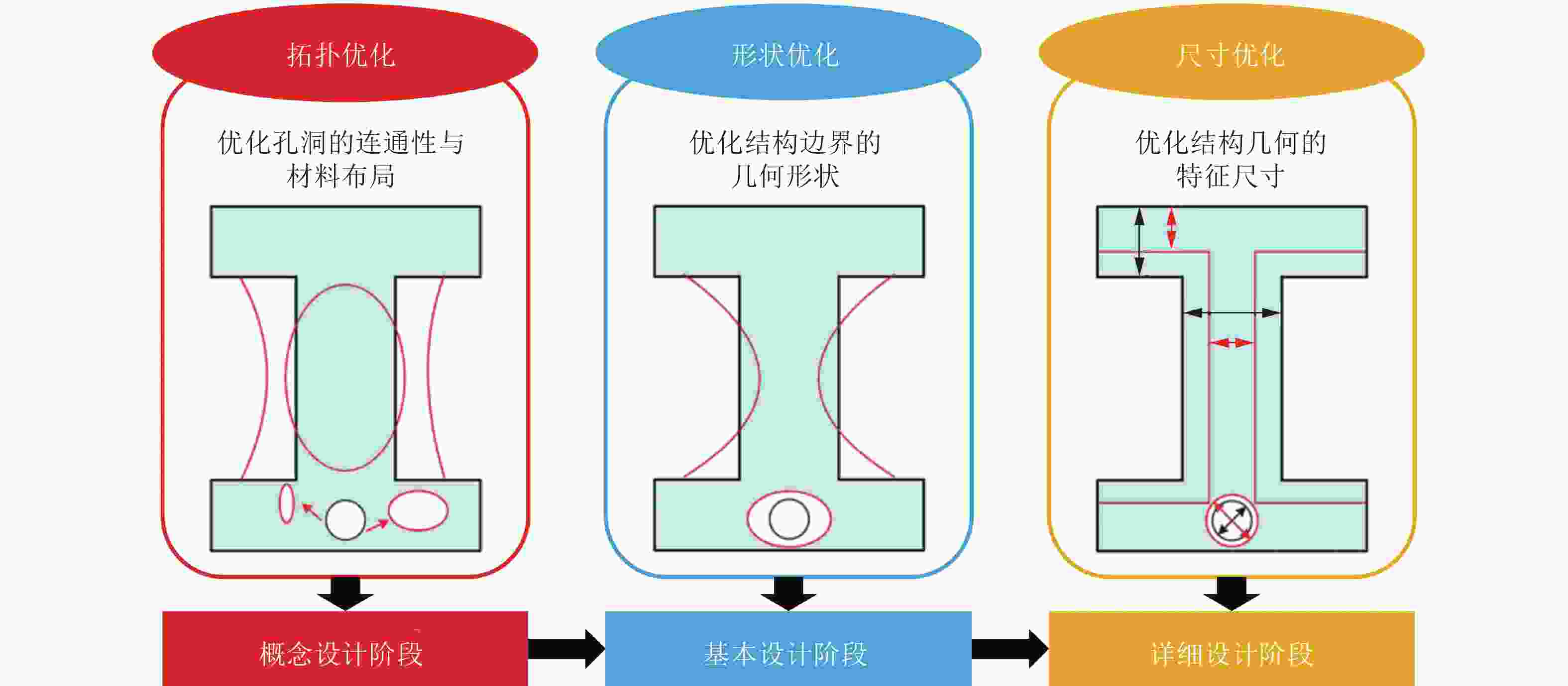
 下载:
下载:






